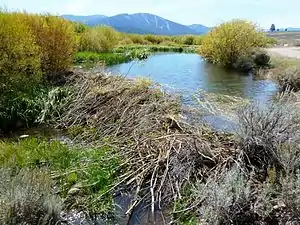| Martis Creek | |
|---|---|
 Beaver dam upstream of Martis Reservoir creates additional trout habitat. Northstar at Tahoe in background. | |
 Location of the mouth of Martis Creek in California | |
| Location | |
| Country | United States |
| State | California |
| Region | Placer County & Nevada County |
| City | Truckee, California |
| Physical characteristics | |
| Source | Sawtooth Ridge, west of the peak of Mount Pluto |
| • coordinates | 39°14′33″N 120°09′21″W / 39.24250°N 120.15583°W[1] |
| • elevation | 7,305 ft (2,227 m) |
| Mouth | Confluence with the Truckee River |
• coordinates | 39°21′00″N 120°07′06″W / 39.35000°N 120.11833°W[2] |
• elevation | 5,666 ft (1,727 m)[2] |
| Basin features | |
| Tributaries | |
| • right | West Fork Martis Creek, Middle Fork Martis Creek, East Fork Martis Creek, Dry Lake Creek |
Martis Creek is a northward-flowing stream originating on Sawtooth Ridge, west of the peak of Mount Pluto in Placer County, California, United States.[1] After crossing into Nevada County, California, it is a tributary to the Truckee River on the eastern side of Truckee.
History
An archaic Native American people known as the Martis people lived in the Martis Creek watershed from 2000 BCE to 500 CE. William Brewer of the California Geological Survey referred to the area by its Washoe name "Timilick Valley". It is supposed that the creek, valley and peak were all named after a rancher named "Martis".[3]
Watershed
The Martis Creek watershed is east of the Sierra Nevada crest and drains 42.7 square miles (111 km2).[4] It has four perennial tributaries, in order (heading downstream): West Fork Martis Creek, Middle Fork Martis Creek, East Fork Martis Creek, and Dry Lake Creek. The tributaries join Martis Creek above Martis Creek Reservoir, except for Dry Lake Creek.
The United States Army Corps of Engineers (USACE) has identified significant problems with Martis Dam, including significant seepage and seismic dangers which they are currently studying. Shortly after its construction in 1972, the seepage was discovered and the water behind the dam has been maintained at a minimal level since.[4]
Ecology
The Northstar Habitat Management Plan is being developed to enhance the forests, aquatic, riparian, and meadow habitats around Northstar at Tahoe, recognizing that these environments provide habitat for a range of sensitive species, including northern goshawk (Accipiter gentilis), California spotted owl (Strix occidentalis occidentalis), pileated woodpecker (Dryocopus pileatus), American marten (Martes americana), mule deer, willow flycatcher (Empidonax traillii), mountain yellow-legged frog (Rana muscosa), and mountain beaver (Aplodontia rufa).[4]
North American beaver (Castor canadensis) have re-colonized Martis Creek. The presence of beaver dams has been shown to either increase the number of fish, their size, or both, in a study of brook, rainbow and brown trout in Sagehen Creek, which flows into the Little Truckee River.[5] Recently novel physical evidence demonstrated that beaver were native to the Sierra until at least the mid-nineteenth century, via radiocarbon dating of buried beaver dam wood uncovered by deep channel incision in two locations in Red Clover Creek, a Feather River tributary that is also east of the Sierra Nevada crest.[6] Beaver ponds are associated with high cutthroat trout (Oncorhynchus clarki) populations in a study of successful translocations into streams in Colorado and New Mexico because they provide deep pond refugia for adult trout in small headwater streams.[7]
Prior to the arrival of European inhabitants and fish species declines probably related to logging and overgrazing, Martis Creek was an important year-round fishery for the Washoe people. Fishery resources included Lahontan cutthroat trout (Oncorhynchus clarki henshawi) (LCT) and a variety of smaller species, such as sucker and chub.[4] In June 1978 the California Department of Fish and Game stocked LCT in Martis Creek Reservoir, after reducing non-native resident trout using piscicides. This stocking attempt was unsuccessful.[8]
See also
References
- 1 2 U.S. Geological Survey. National Hydrography Dataset high-resolution flowline data. The National Map Archived 2012-03-29 at the Wayback Machine, accessed October 21, 2012
- 1 2 U.S. Geological Survey Geographic Names Information System: Martis Creek
- ↑ Barbara Lekisch (1988). Tahoe Place Names: the Origin and History of Names in the Lake Tahoe Basin. Lafayette, California: Great West Books. p. 142. ISBN 9780944220016. Retrieved 2012-10-21.
- 1 2 3 4 Balance Hydrologics. Martis Watershed Assessment, Placer and Nevada Counties, California (PDF) (Report). Truckee River Watershed Council. Retrieved 2012-10-21.
- ↑ Gard R (1961). "Effects of beaver on trout in Sagehen Creek, California". Journal of Wildlife Management. 25 (3): 221–242. doi:10.2307/3797848. JSTOR 3797848.
- ↑ James, C. D.; Lanman, R. B. (Spring 2012). "Novel physical evidence that beaver historically were native to the Sierra Nevada". California Fish and Game. 98 (2): 129–132.
- ↑ Amy L. Harigi; Kurt D. Fausch (2002). "Minimum Habitat Requirements for Establishing Translocated Cutthroat Trout Populations" (PDF). Ecological Applications. 12 (2): 535–551. doi:10.1890/1051-0761(2002)012[0535:mhrfet]2.0.co;2. Retrieved 2012-10-25.
- ↑ Peter B. Moyle; Bruce Vondracek (February 1985). "Persistence and Structure of the Fish Assemblage in a Small California Stream". Ecology. 66 (1): 1–13. doi:10.2307/1941301. JSTOR 1941301.